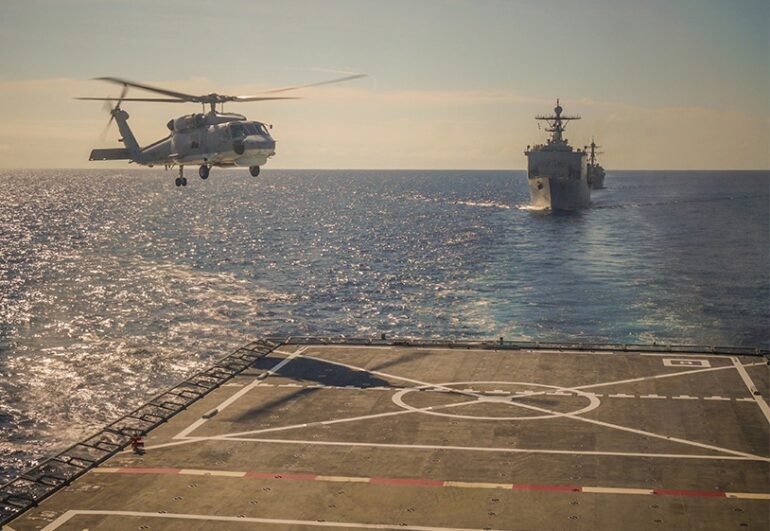TL;DR:
- Texas A&M engineers, funded by the US Navy, are pioneering automated aircraft landings on turbulent seas.
- They employ machine learning to emulate helicopter pilot behavior, focusing on a specialized horizon bar for navigation.
- The project merges aerospace and electrical engineering, designing robust VTOL aircraft and precision reinforcement learning algorithms.
- Key objectives include runway-independent aircraft, enhanced cruise efficiency, and safe landings on moving ship decks.
- Their interdisciplinary collaboration promises groundbreaking advancements in autonomous naval aviation.
Main AI News:
In the realm of naval innovation, Texas A&M engineers are at the forefront, spearheading a cutting-edge endeavor that could redefine aircraft landings on turbulent seas. With generous backing from the US Navy, these engineers are poised to revolutionize the future of autonomous vertical takeoff and landing (VTOL) aircraft.
The challenge at hand is formidable. The treacherous conditions of rough seas demand a solution that can adapt seamlessly. This is where Texas A&M University researchers step in, armed with a visionary approach that combines optimal aircraft design with a robust machine learning algorithm. Their goal is to reshape the landscape of automated aircraft ship landings in the face of adversity.
Dr. Moble Benedict, an esteemed associate professor in the Department of Aerospace Engineering at Texas A&M, leads the charge as the project’s principal investigator. He elucidates the critical element of this pioneering approach, stating, “When a helicopter pilot endeavors to touch down on a ship’s deck, they eschew direct focus on the deck’s motion. Instead, they rely on a specialized piece of equipment known as the horizon bar—a green, lighted, gyro-stabilized strip that provides them with an artificial horizon.“
In a departure from recent studies that are fixated on tracking the ship’s deck using cameras, GPS, and lidar, Benedict and his partner in innovation, Dr. Dileep Kalathil, an assistant professor in the Department of Electrical and Computer Engineering, chart a different course. They aim to automate the landing process by emulating a pilot’s behavior while tracking the horizon bar.
Kalathil elucidates the core technology at play, “Reinforcement learning, a prominent facet of machine learning, serves as the bedrock for crafting the control algorithm for autonomous systems. We are crafting a precision-engineered reinforcement learning control algorithm capable of tracking the horizon bar with unparalleled accuracy—even when faced with the challenges posed by unpredictable factors like changing course or encountering heavy winds.”
The fusion of aerospace engineering and electrical and computer engineering marks the union of these two brilliant minds. Benedict notes, “My focus revolves around crafting the next generation of VTOL aircraft tailored for robust ship-based operations, emphasizing efficiency and understanding the intricacies of their flight dynamics.” On the other front, Kalathil concentrates on refining the reinforcement learning algorithm, ensuring it thrives in highly uncertain environments.
The Navy’s vested interest in this project encompasses three pivotal elements: the development of an aircraft capable of vertical takeoff and landing, independence from traditional runways; enhanced cruise efficiency, enabling extended flight durations; and the capability to land safely on moving ship decks.
Benedict leverages his expertise in rotorcraft to design VTOL aircraft concepts resilient to gusts and remarkably efficient. These concepts might even incorporate innovative features like foldable wings for transitioning from vertical flight to fixed-wing cruise. Rigorous simulations, wind tunnel tests, and flight trials will be undertaken to analyze performance and dynamics, culminating in the creation of a subscale model complementing Kalathil’s advanced control systems.
Kalathil’s realm of expertise lies in reinforcement learning, where he molds an algorithm that can navigate the roughest of conditions with aplomb. It optimally harnesses real-time data, mirroring a pilot’s adaptive response. He asserts, “One of the primary challenges in autonomous ship landing lies in the capricious nature of rough seas. However, the incorporation of a wind sensor in the UAS assembly, measuring wind speed and direction, equips us to counteract these specific conditions.”
The adaptability of their approach bridges the gap between simulations and real-world deployment, a perennial challenge in technological advancements. Kalathil even explores the possibility of utilizing a collaborative console to oversee multiple UASs.
The US Navy has committed to funding this ambitious three-year project, entrusting Benedict and Kalathil to engineer a robust solution for automated VTOL aircraft ship landings. Their interdisciplinary collaboration at Texas A&M promises to chart a course toward a promising future in autonomous naval aviation.
Conclusion:
The groundbreaking work by Texas A&M engineers represents a significant leap in autonomous aircraft technology, catering to the unique demands of Navy operations on rough seas. This development holds immense promise for both the defense and civilian sectors, paving the way for safer and more efficient autonomous aircraft operations, even in the most challenging conditions. As autonomous technology matures, industries beyond defense will likely explore applications in logistics, search and rescue, and remote operations, opening new avenues for market growth and innovation.

